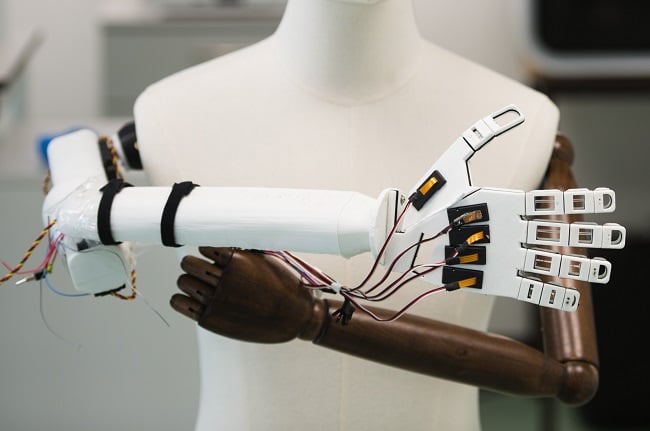At the University of Glasgow (UofG), the Bendable Electronics and Sensing Technologies group (BEST) are working on affordably manufacturing prosthetic arms by using the latest 3D printing techniques. The UofG project, which involves nanoscale engineers and engineering students at the PhD and MSc (Master of Science) level, is known as ‘Helping Hands’.
More on 3D-printed Prosthetics
As touched on above, there is a cost-effective benefit to 3D-printing prosthetics, particularly when compared to purchasing the traditional, commercial version of artificial limbs. As Dr Ravinder Dahiya, the BEST group conveyor at UofG’s School of Engineering explains:
“With prosthetics, because of physical changes in the body, amputees may experience changes in the physical size of their limbs, making it necessary to develop the socket or whole limb all over again. Commercial artificial limbs are prohibitively expensive, so frequently replacing them, for example in the case of child amputees, can be difficult.”

Dr Ravinder Dahya pictured with the bendable, wireless communication-friendly prosthetic hand. Image Credit: the University of Glasgow.
3D printing is basically a technique of additive manufacturing: based on its computer programming and commands (as inputted by the user), it develops a product layer by layer without wasting the requisite material. The engineers working on the 3D-printed prosthetic arm at the University of Glasgow explain the benefits of additive manufacturing as follows:
- 3D printing-based design enables the products to be manufactured out of one part. This means it requires no assembly.
- 3D printing-based design allows the manufacture of very complex geometries, particularly when compared to other processes.
- The parts produced by 3D printing are more affordable than traditional components.
- 3D printing allows manufacturers to reach their end product far more efficiently than traditional approaches to production. It altogether allows engineers to achieve rapid (and affordable) product designs and improvements.
The Problem of Using Non-wireless Communication in 3D-printed Prosthetics
In spite of the above benefits, Dr Ravinder Dahya states that there are currently problems that arise from the wiring and circuitry within existing designs of prosthetic limbs. The large number of wires within a prosthetic design is a particular concern, and this, as Dahya writes in his research paper (‘Tactile Sensing—From Humans to Humanoids’), is one of the core obstacles when using numerous wires to transmit data from a large number of tactile pixels, i.e. ‘taxels’. Taxels are the sensors that sense pressure when applied by any physical object.
As the transmission of tactile data is normally processed through serial buses, the constraints and limiting factors (like noise, speed, complex circuitry, and excess use of wires) give rise to communication channel issues. This is as those channels have to interact at higher levels to overcome such interfering factors as those mentioned above. Put simply, the larger the number of wires in a system, the more power consumption is needed.

Wireless communication within a 3D-printed prosthetic arm. Image Credit: the University of Glasgow.
Another problem that arises from the abundant circuitry of prosthetic designs is that the wires increase the weight of the artificial limb prototype. This hinders the patient’s ability to handle the device.
The Need for Wireless Communication in 3D-printed Prosthetics
For the relevant data to be transferred in a non-wireless prosthetic device, different electrical paths with different transfer rates are required: signals that need to be transferred on an urgent basis.
The research of Dr Ravinder Dahya et al, however, has explained that this type of non-wireless electronics communication is not desirable for robotics: “[T]he early [robotics] solutions are nowhere close to the complexity of the … systems needed today”, write the researchers. Rather, wireless data transmission within prosthetics is the ideal basis for transferring electrical signals.
Dahya suggested that wireless data transmission will ease the use of flexible and stretchable sensing arrays. After all, if no wireless data transmission is used for these stretchable and flexible sensing arrays, the prosthetic device will require an unwieldy amount of interconnects and wiring, which will in turn make the circuit unnecessarily complicated.
On top of this, UofG’s researchers explain that the conventional designs of prosthetics are altogether overly basic and provide very limited movement to the patients who use them. Again, conventional artificial limbs that use internal circuitry based on non-wireless signal connections have several drawbacks, and this highlights all the more the advantages of 3D-printed, wireless communication-based prosthetics. As covered next, such medical technologies have allowed amputees to experience greater stability and ease of movement, among other breakthroughs.

Dr Ravinder Dahya stands behind a mannequin that is connected to the robotic prosthetic arm.
The Core Benefits of Wireless, 3D-printed Prosthetics
On top of the above benefits of wireless artificial limbs, wireless communication also enables prosthetic hands to communicate intuitively with their wearers’ muscles, and this grants the patient greater dexterity and finger movements. Such prosthetic hands tend to move and react in a natural way, whereas their conventional, wired equivalents often tend to produce a much greater strain on what are often the patients’ already-damaged muscles.
Moreover, when compared to conventionally-manufactured, wired prosthetic models, 3D-printed and wireless-based prosthetic designs allow manufacturers to more easily make their desired adjustments based on the needs of patients. 3D printing itself, in fact, is meeting the demands of a great number of disciplines. From engineering to medical sciences, additive manufacturing—and, by extension, rapid prototyping—is now more prevalent than ever. Such methods of production bring efficiency, reliability, and even simplicity to the production of prosthetics and other much-needed technologies.






